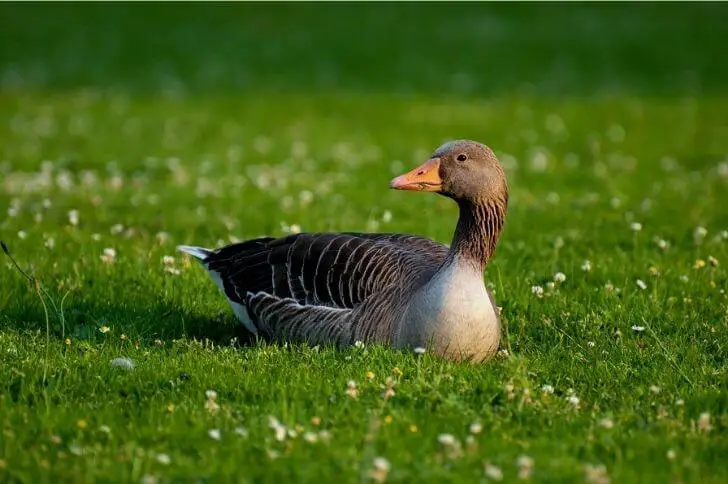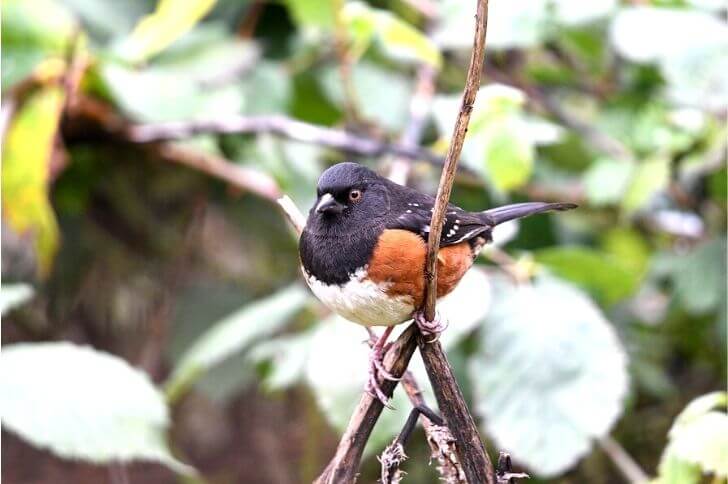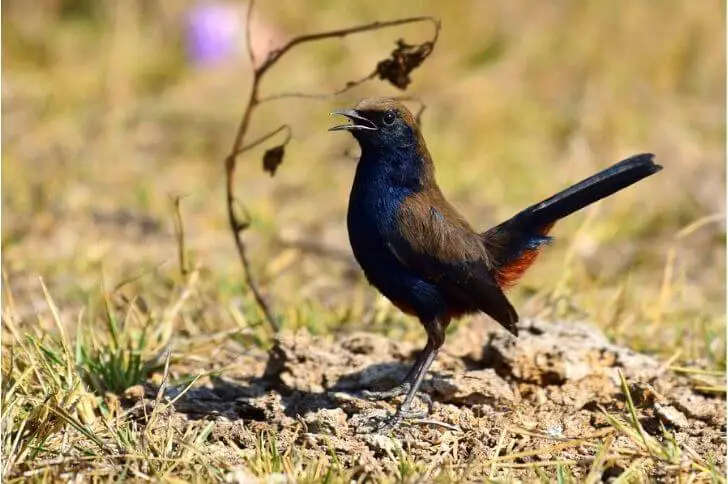There are many birds that start G. You may have heard about some of them like the goldfinch or golden. This list contains 33 of the most interesting birds that start with letter g including popular ones and lesser known birds like the golden-fronted fulvetta.
If you are a bird enthusiast, there are plenty of birds on this list to add to your ‘must-see birds list’. If you are looking for answers to a crossword puzzle, you’ll find the right answer here.
Birds that start with G
1. Gabar goshawk
The Gabar Goshawk is a medium-sized raptor that is found in open and semi-open habitats in Africa.
They are very opportunistic hunters and will take a variety of prey, including small mammals, birds, reptiles, and insects.
They are also known to scavenge on carrion. Gabar Goshawks are generally shy and secretive birds, but can be quite aggressive when defending their territory or hunting.
2. Golden eagle
The golden eagle is one of the most majestic and loved birds in North America. They can weigh up to 5.5 pounds (males) and 8.9 lbs (female).
Their large wings, up to 8 feet wingspan, allows them to fly at speeds of up to 150 mph. Golden eagles are opportunistic predators that feed on a variety of prey, including small mammals (such as rabbits, hares, and ground squirrels), medium-sized mammals (such as deer, elk, and coyotes), fish, carrion, and occasionally other birds.
They are also known to scavenge kills made by other predators. In some areas, they have been known to take down lambs.
3. Gabela bushshrike
The Gabela bushshrike is a beautiful bird that is commonly found in Angola. This bird that start with the letter G is a medium-sized bird.
It has very distinctive features; black back and wings, white underparts, and a chestnut crown. They are known for their beautiful song, and they are usually seen in pairs or small groups.
Gabela bushshrikes are monogamous, and the female builds the nest and takes care of the young.
Related Read: Here is a list of birds that start with t
4. Galah
Also known as the rose-breasted cockatoo, Galah is another beautiful bird that starts with g. Widely found in open woodlands and grasslands of Australia, the galah is distinguishable from other cockatoos because of its vibrant pink coloring.
These birds are social and playful, making them popular pets. They can be trained to do tricks and mimic human speech. Wild Galahs usually form flocks of 10-30 birds and pet birds can become very attached to their owners.
5. Gambel’s quail
Gambel’s quail are a North American bird that is part of the New World quail family. This ground-dwelling bird can be found in many different habitats, including grasslands, deserts, and scrublands.
Like other quals, this bird prefers walking around than flying. And when it does fly, it’s only for short distances.
The Gambel’s quail are monogamous and breed in spring. A female lays up to 10 eggs which takes about three weeks to hatch. The chick’s meal is mostly made up of insects and plants as they mature. This bird is a must see for any bird enthusiast.
6. Garden warbler
Another group of passerine birds that start with g are the garden warblers. Found in most of Europe, the male has brown back and head, whitish underparts.
The Garden warbler prefers open woodlands. Breeding often starts when the birds turns one year old with a female laying up to five eggs. They incubate for a period of 12 days and fledge at day 10 of their existence.
Garden warbles feed on spiders, smaller insects and berries. How long do garden warblers live? Up to two years but one warbler lived up to 10 years under captivity.
7. Great blue heron
The great blue heron is a large wading bird found near water bodies. They have a long neck and legs, and can be recognized by their bluish-gray color and white feathers on their head.
Great blue herons typically eat fish, but will also eat small mammals, reptiles, and amphibians. They are usually solitary birds, but sometimes form colonies during breeding season.
Related: Names for birds
8. Garnet robin
The garnet robin is a small passerine bird that is found in open woodlands in New Guinea (Africa).
This timid bird typically lives in pairs or small groups. It feeds on fruit, insects and other small invertebrates, which it gleans from tree branches and foliage. The song of the garnet robin is a series of soft whistles.
9. Garganey
Weighing just under 1 pound, the garganey is a small migratory dabbling duck. The males are more colorful and vocal compared to the female ducks.
Boasting a wingspan of up to 27 inches (69cm), the garganey breeds in northern Europe and Asia and migrates to Southeast Asia and Africa during colder or winter months.
The garganey feeds on aquatic invertebrates and plant material. It often feeds by tipping up on the water to reach food items below the surface.
10. Giant conebill
The giant conebill is a large songbird that is found in the Amazon rainforest of South America. With grey upperparts and chestnut underparts, this bird is easy to identify from other rainforest birds.
This bird forages polylepis trees for its meals and can fly for long distances looking for patches with this type of tree. It often moves around alone or in pairs when breeding.
11. Germain’s peacock-pheasant
In our article about birds that start with h, we looked at the hainan peacock-pheasant. For this article we’ll look at a closely related bird, the Germain’s peacock- pheasant.
The Germain’s peacock-pheasant is a bird that also belongs to the phasianidae family. It is a large bird, with males being larger than females.
The plumage of this bird is quite striking, with males having a blue head, gray body, and gray-black wings. The tail feathers of the male are also very impressive, being up to two feet long and featuring many colorful eyespots.
The diet of the Germain’s peacock-pheasant consists mainly of seeds, fruits, and insects. They can also run quickly on the ground when necessary. These birds are monogamous, and both male and female take care of the eggs and young.
12. Gentoo penguin
Great swimmers and avid hunters, the Pygoscelis papua or Gentoo penguin is a penguin species in the genus Pygoscelis.
This curious bird is one of the largest penguin species, standing up to 90cm (35 in) tall and weighing up to 18lb.
These cute birds feed mostly on fish, lobsters and crustaceans. The Gentoo is a popular tourist attraction in Antarctica.
13. Golden monarch
With its striking yellow plumage, teardrop pattern eye and black long tail, the golden monarch is a sight to behold. Found in lowland forest, this bird will be a great addition to your photo collection.
The golden monarch measures about 5.5 inches and produces a high whistling sound.
14. Glaucous tanager
The glaucous tanager is a songbird found in lowlands forests in Venezuela. They are a striking bird, with a bright grey head, blue wings, and underparts.
They are usually seen in pairs or small groups, and they are known for their loud, melodic songs. Glaucous tanagers eat insects and fruit, and they build their nests in trees or bushes.
15. Giant ibis
The giant ibis is another bird that start with G. Mostly found in Cambodia, it is the largest member of the ibis family and can measure up to 41 in length, stand at 39 inches and weigh up to 9.3 lb.
The giant ibis has a long, dark bill, dark eyes, and long legs. The body is mostly grey with a black tail.
This bird beginning with letter h inhabits swamps, marshes, and wet rice paddies where it feeds on a variety of prey including fish, crabs, frogs, snakes, small mammals, and insects. It is a social bird. The giant ibis nests in trees near watercourses; the nest is a platform of sticks lined with leaves.
16. Golden parrotbill
Small, cute and charming are the words that best describe this passerine bird. The Golden parrotbill can be found in bamboo forests and scrubs.
The males are brightly coloured, with a yellow head, upperparts and underparts, long tail and whihte throat. These birds are very vocal and feed on insects, nectar and fruit.
17. Giant coua
Found in Madagascar, the giant coua is another type of bird with g letter on their name. It is a mid-sized bird that is a member of the cuckoo family. The giant coua is a ground-dwelling bird meaning it prefers walking around to flying.
This bird has a long tail and the male and female work together to care for their young.
18. Goldfinch
The goldfinch is a small passerine bird that is found in North America, Europe, and Asia. These birds are typically yellow and black in color, but can also be found in other colors such as white.
Male goldfinches are brighter in color than females. Goldfinches are seed eaters and prefer to feed on thistle seeds. They are also known to visit bird feeders. Goldfinches build their nests out of materials such as grass, twigs, and hair.
Goldfinches have been known to be very tame birds and have even been kept as pets. They are also known for their beautiful singing voices.
19. Gila woodpecker
Found in parts of the US and Mexico, the Gila woodpecker is another bird that starts with H. This medium-sized bird is easily identified by their greyish-tan plumage on their head and underparts, speckled back, as well as the characteristic red patch on their head.
Gila woodpeckers forage for insects on tree trunks and branches, and often create holes in trees while hunting for food. They are also known to store food in these holes for later consumption. Gila woodpeckers typically live in mixed pine-oak forests, but can also be found in other types of habitats such as deserts and riparian areas.
20. Grouse
Another bird that is part of the Phasiandae family is the Grouse. Widely in temperate regions, this bird with g can weigh up to 14.5 lb.
There are several different species of grouse, and they vary in size and color. When it comes to breeding, males make very elaborate shows to win over females. Incubation period lasts for 21 – 28 days.
These birds are known for their strong wings and fast flight. They can often be seen darting through the trees or flying high overhead. Grouse are hunted for sport, and their meat is considered a delicacy.
21. Gilliard’s honeyeater
Inhabiting tropical and subtropical forests, the bismarck honeyeater or gillard’s honey eater is a small bird with a long beak. It is a member of the honeyeater family, Meliphagidae, and is related to the white-eared honeyeater.
The Gilliard’s honeyeater is sexually dimorphic, with the male being black above and white below, while the female has mostly olive-green plumage. The species feeds on nectar and insects, and is monogamous.
22. Glaucous gull
The glaucous gull is a large seabird that can be found in arctic regions. They are easily identified by their pale gray plumage and bright white wingtips and underparts.
Glaucous gulls are scavengers and will eat almost anything, including insects, fish, crabs and other small animals.
They are also known to steal food from other birds. Glaucous gulls breed in colonies on coastal cliffs or islands, and the females lay two to three eggs in a nest made of grasses or moss.
23. Glossy ibis
The glossy ibis is a wader in the ibis family. It breeds in much of Europe and Asia, and also in Africa north of the equator.
Glossy ibises are medium-sized birds, being 26 inches long with a 41 inch wingspan.
They have long legs and necks, and are mostly reddish-brown with shiny green wings and tail feathers. The bill is gray, long and slightly curved and the eyes are dark brown. Males and females look similar, but young birds are duller than adults.
Glossy ibises diet consists of insects, fish, amphibians, reptiles and small mammals.
24. Glaucous macaw
Measuring about 28 inches in length, the glaucous macaw is a striking parrot that is found in central and South America.
These birds are mostly green, but they have a blue tinge to their feathers that becomes more pronounced in adults.
They have a long tail, white cheeks, and a black beak. Glaucous macaws are usually quiet birds, but they can make loud screeching noises when they are alarmed or excited.
25. Gilded flicker
Another gracious woodpecker that belongs to the list of birds that start with h is the gilded flicker. This large woodpecker is found in the southwestern United States and parts of Mexico.
They are easily recognized by their black and white barred plumage, and their golden yellow underwings. Gilded Flickers inhabit open woodlands, riparian corridors, and agricultural areas.
They forage on the ground for ants and other insects, but will also visit feeders for suet or birdseed. Gilded Flickers are monogamous, and both parents help care for the young.
26. Giant sunbird
The giant sunbird is a species of bird in the Nectariniidae family.
Its natural habitats are subtropical or tropical moist lowland forests and subtropical or tropical moist montane forests. This bird features black upperparts with yellow underparts. It is threatened by habitat loss.
27. Glow-throated hummingbird
Part of the hummingbird family, the glow-throated hummingbird is a small bird that feeds on nectar and small insects.
It has a green back, greyish underparts, and a reddish-purple throat. They can fly very quickly, up to 55 miles per hour! These birds are considered endangered.
28. Golden parakeet
Looking for a bright and cheerful pet? Native to South America, the golden parakeet has a beautiful, bright yellow color.
These birds start breeding when they turn three with the female laying up to 4 eggs which it incubates for 30 days.
Golden parakeets are social animals and typically live in flocks. They are also very vocal and can often be heard making loud screeching or chirping sounds.
29. Golden-backed weaver
The golden-backed weaver is a colorful bird that can be found in Africa. This bird is a member of the weaver family, and it gets its name from the bright yellow feathers on its back.
Also known as the Jackson’s weaver, this bird is a social bird, and it lives in colonies with other weavers. These birds use their beaks to build intricate nests out of straw, grass, and other materials. The golden-backed weaver eats insects and plants.
30. Goldenface bird
The goldenface is a medium-sized bird that is found in open woodlands and scrub habitats.
This passerine has a gray back and wings, bright underparts, face and throat. The sexes are similar in appearance, but juveniles are paler than adults.
These birds that start with g typically forage on the ground for insects, but they can also be seen gleaning food from trees and shrubs. These birds are very vocal and often sing from high perches in the open sky. Goldenfaces build sturdy nests out of sticks, which they place in clumps of trees or shrubs.
31. Golden-fronted fulvetta
Golden-fronted fulvetta is a passerine bird found in the moist forests. Fulvettas are in the same family as wrens, and these birds are related to the American dipper and the European wren.
They are small, sparrow-sized birds, with a long tail. Golden-fronted fulvetta has a bright yellow face and throat, set off against a grey head and back. The rest of its body black patches. This species is found in open woodlands at high elevations, where it forages for insects on the ground.
32. Greylag goose
The greylag goose is a large waterbird that inhabits warmer regions. The graylag can be found in a variety of wetland habitats, such as marshes, lakes, rivers, and estuaries.
The greylag geese measure up to 36 inches in length and the male can weigh up to 7 lbs. Their wingspan ranges from 58 to 70 inches and the birds often migrate during winter to warmer regions.
These geese feed on a variety of aquatic plants and insects. Greylags are monogamous birds and typically mate for life. Nests are built on the ground near water and typically contain four to eight eggs.
33. Ground tit
With its small, slightly curved black beak, grayish plumage, and short black legs, the ground tit is a small bird that is native to some Asian countries.
This passerine prefers shrubs to forests. It also prefers walking around, foraging for food. When it comes to breeding, this bird lays up to 6 eggs and the birds are mostly monogamous.
Sources:
https://www.deschuteslandtrust.org/news/blog/2017-blog-posts/ten-facts-about-golden-eagles
https://www.nationalgeographic.com/animals/birds/facts/gentoo-penguin
Hi fellow bird watcher. Welcome to our small corner of the world. At the spanishbirdguides.com our mission is to share with other bird watchers the things we love about birds, where to go bird watching within the United States, and more. I’d also love to hear from you. Feel free to contact me about your bird watching escapades, share videos, photos and more.




